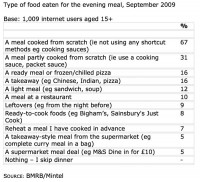 The home is right at the centre of most consumers’ lives and is the place where they choose to centre most of their activities. This is true even for the most socially active under-25s.
The home is right at the centre of most consumers’ lives and is the place where they choose to centre most of their activities. This is true even for the most socially active under-25s.
Accordingly people need a diverse meal repertoire to meet all occasions, and this broad range means potential growth opportunities for every food category.
Although a minority do make time for a proper meal at lunchtime there can be little doubt that this is not a realistic choice for most working adults during the week, and it is probable that most consumers now prefer to eat their main meal in the evening anyway. The weekend allows greater freedom of choice of course for leisurely lunches.
Indeed, today, two-thirds of adults cook their evening meal from scratch. However, most draw upon a repertoire of meal options that includes take-aways and ready meals.
Consumers who typically eat ready meals and takeaways in the evening are more likely to eat a larger meal at lunchtime and to work irregular hours. But this group spends more time cooking at the weekend.
Looking at consumer groups within society, today, one in three men claims to do all the cooking, something not reflected by the media, food promotions or packaging. However, on the flip side, men are more likely than women to eat out, suggesting that it is a direct substitute for home cooking, an area where women remain more involved.
Increasing numbers of single person households and older consumers present opportunities for both the food industry and public health bodies to stimulate their interest in food and cooking.
Looking at shopping habits, although the great majority of consumers rely on one big weekly or fortnightly shop, relatively few have a systematic approach to meal planning.
Consumers are around three times as likely to decide what to eat on a day-to-day basis as to plan their meals ahead and to spend more time cooking at the weekend. This extra effort includes cooking meals ahead of time to stock the freezer. The planners are notably more upmarket than average.
Most evening meals are adult-only affairs with just a quarter of adults eating with children, and this is in line with population demographics. It does not indicate any dramatic fragmentation of eating patterns in the family unit.
Furthermore those who eat as a family are the most likely to cook from scratch and to dine at the table, although this is still the most popular choice among all households.
Two in ten adults by contrast eat alone, and these are the most likely to just eat a ready meal or something light in the evening rather than cook from scratch.




Comments are closed.